Jackson Avenue: MDOT Stays in Its Lane
A three-hour open house held at Abbot Elementary School on July 10 drew several supporters and opponents of a four-to-three lane conversion for Jackson Avenue on Ann Arbor’s west side.
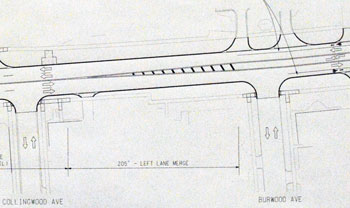
Under the planned 4-3 lane conversion, four lanes (two each way) would stay in place from the Maple and Jackson intersection eastward through the intersection of Collingwood and Jackson. From Burwood eastward to Dexter-Ann Arbor, one lane would be dedicated in each direction, with the third, middle lane assigned to turning vehicles. (Photos by the writer.)
However, the point of the open house was strictly informational. The Michigan Dept. of Transportation had already made a decision to convert the Jackson Avenue segment – between Burwood and the Dexter-Ann Arbor “Y” in the road – from four to three lanes. That decision came after the Ann Arbor city council passed a resolution at its April 2, 2012 meeting that made a formal request of MDOT to make the conversion.
But the initial request for MDOT to consider a 4-3 lane conversion had come much earlier – from the city of Ann Arbor project management staff. That request resulted in a February 2012 public meeting to solicit public input, when MDOT staff presented the proposal and their traffic analysis. MDOT expects the lane conversion to reduce accidents along the corridor.
The lane conversion, which amounts to re-striping the lanes, not changing the roadway footprint, is scheduled to coordinate with an MDOT road resurfacing project. That project is now expected to be implemented in the spring of 2014. It also includes the portion of Jackson westward to the I-94 interchange.
MDOT staff were on hand Tuesday evening to answer questions. Arranged around the cafeteria were several easels with schematics of the road design, and posters displaying crash statistics and peak traffic flows. Peak attendance at the open house for the first hour was probably around 40 people, which included city of Ann Arbor staff and three city councilmembers – Jane Lumm (Ward 2), Mike Anglin (Ward 5) and Sabra Briere (Ward 1). Lumm and Anglin had voted against the city council’s resolution on lane conversion.
Attendance was hard to judge – because of the open house format, as people filtered in and out. One measure of the strong opinions held by people in the room was two separate attempts by Ann Arbor resident Libby Hunter to call the room to order. The first time was to take a straw poll on the sentiments in the room for and against the lane conversion. On the second occasion, Hunter tried to impose a bit more structure on the open house format, by suggesting that people gather around a table for a question-and-answer session.
This article begins with some basic background on the historical impetus behind the city of Ann Arbor’s current focus on Jackson Avenue. It draws in a limited way on the experience of other communities in Michigan with 4-3 lane conversions.
The article includes a section on the arguments for 4-3 lane conversions, and current criteria used as guidelines to determine appropriateness of such conversation. Included is an MDOT-commissioned study (not yet adopted by MDOT or the Federal Highway Administration) that came out earlier this year, suggesting a substantial revision to those guidelines.
And because many of the arguments for 4-3 lane conversions are based on the possibility that traffic accidents can be reduced, the article includes a final section on crash data. That final section also includes crash data maps for Ann Arbor traffic accidents from 2004-2011 in a variety of different categories – deer, bicyclists and the “elderly.”
Jackson Avenue: Historical Background
Some of the conversation among Ann Arbor residents about the 4-3 lane conversion has focused on the question of who’s responsible for the decision – MDOT, city staff, the city council, or residents? For Ann Arbor, we go back 10 years.
Jackson Avenue: Historical Background – Ann Arbor
City of Ann Arbor traffic engineer Les Sipowski has worked for the city long enough to remember the early 2000s, when the Jackson-Huron neighborhood association was active in raising awareness about the problems with the corridor. The geographic boundary of the neighborhood association flanks Jackson and Huron, from Maple to Main.
In a telephone interview, Sipowski told The Chronicle his recollection is that members of the neighborhood group had brought the issue of high-volume, high-speed traffic to the attention of politicians in the early 2000s. The association asked the city to “do something” to improve pedestrian safety. So the city’s engineering staff began to explore what that “something” might look like – a decade ago.
A review of city council minutes turned up a resolution from Aug. 19, 2002 that established a task force “to formulate traffic calming recommendations to city council that can be forwarded to the MDOT for implementation.”
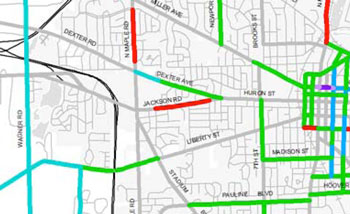
From 2007 City of Ann Arbor Non-Motorized Plan: Near-term Road Changes. Red segments are those identified as possibilities for 4-3 lane conversions. Green segments are proposed for motor vehicle lane narrowing with the addition of bicycle lanes. Teal segments are proposed for elimination of one lane.
By 2007, the idea of a change to the roadway – from 4-3 lanes – and installation of bicycle lanes was part of the city’s non-motorized plan, approved by the city council. Those concepts were then incorporated into the city’s transportation plan update. The transportation plan update was approved by the city council at its May 4, 2009 meeting.
When MDOT placed the Jackson Avenue resurfacing project on its work schedule, city of Ann Arbor staff requested the 4-3 lane conversion as part of the project.
So when MDOT held a public meeting on Feb. 16, 2012 asking for input on the proposed project, the slide presentation summary of the 4-3 lane conversion included the bullet point: “Requested by the City of Ann Arbor.” Homayoon Pirooz, head of project management for the city, told The Chronicle that he’d made that request about three years ago.
Based on the modeling and traffic analysis that MDOT did, and the results of the public input, MDOT asked the city to consider a resolution of support for the 4-3 conversion. From the city of Ann Arbor staff memo accompanying the city council’s resolution approved on April 2, 2012: “At the direction of Michigan Department of Transportation (MDOT) and for MDOT to continue with the process for converting Jackson Ave from 4 to 3 traffic lanes from east of Maple Road to Revena Boulevard, we have prepared the attached resolution for the city council’s approval.”
The city council’s action at its April 2, 2012 meeting met with dissent from two councilmembers – Mike Anglin (Ward 5) and Jane Lumm (Ward 2). Other city councils in Michigan have been confronted with similar decisions about 4-3 lane conversions. In Bessemer, the city council voted in 2009 to ask MDOT to re-stripe a section of US-2 to restore it to four lanes, after MDOT had undertaken a 4-3 lane conversion.
That’s been one selling point of Ann Arbor’s Jackson Avenue 4-3 conversion – that it’s reversible without undue upheaval. Responding to a question from The Chronicle in a telephone interview, MDOT communications representative Kari Arend said that MDOT is not currently contemplating pedestrian refuge islands as part of the project, which would lend the configuration more permanence.
Jackson Avenue: Historical Background – Elsewhere in Michigan
In Owosso, the city council voted in 2010 against recommending that MDOT undertake a 4-3 lane conversion for a section of M-52. It’s described by Owosso city councilmember Tom Cook in a blog post this way:
MDOT has proceeded with this plan because of a request from the City of Owosso several years ago, and because their experience has shown that single lane roads with a center turn lane are safer than highways with two lanes in each direction. However, there has been a large and vociferous expression of public opinion in Owosso against this plan, and the City Council voted 4-3 to request MDOT to keep M-52 a four-lane road. The final decision will be MDOT’s to make.
MDOT’s decision, as relayed by Cook in an email to The Chronicle, was to go ahead with the conversion: “…MDOT felt as if they were too far along in the process and they opted for three lanes on south M-52, which have now been in place for over a year.”
In reflecting on the role of city councilmembers in the decision, Cook made some observations in a blog post on the inherent tensions in decision making that include weighing expert opinion versus popular opinion.
So, what is the expert opinion for 4-3 lane conversion?
Why (Not) Convert from 4 to 3 Lanes?
A central argument for a three-lane configuration is based on an anticipated reduction in accidents. The potential for accident reduction is weighed against the possibility of traffic delays due to capacity issues.
Why Convert: Accident Reduction
Some reduction in accidents and their severity is projected from the expectation of more uniform speeds of vehicles in the roadway.
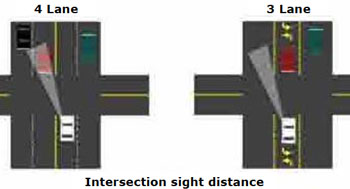
From a slide presentation by Dave Morena, highway safety specialist with the Federal Highway Administration Michigan Division.
But certain types of accidents are also expected to be reduced by dint of the physical configuration: rear-end left turn; head-on left turn; angle; rear end; and sideswipe.
At an intersection, for example, the driver of a left-turning vehicle in a four-lane configuration has two lanes they must scan for oncoming traffic, compared to just one for a three-lane configuration. And in a four-lane configuration, the driver of that same left-turning vehicle must potentially scan for vehicles in the far oncoming lane, which are obscured by vehicles in the near oncoming lane.
Ann Arbor has accumulated some experience with 4-3 lane conversions on its own road projects. In 2008, for example, Platt Road between Packard and Ellsworth was converted from four to three lanes. The city of Ann Arbor provided data to The Chronicle on various accident types before and after the Platt Road lane conversion. The trend for all types is clearly downward, after the 2008 conversion.

Accidents for Platt Road between Packard and Ellsworth. Lane conversion from four to three lanes in 2008.

Platt Road at the intersection of Lorraine. Top photo is from 2005 – a four-lane configuration. Bottom photo is from 2008 – a three-lane configuration.
For the planned 4-3 lane conversion on Jackson Avenue, the lanes along that stretch measure about 10 feet wide, which is two feet narrower than the preferred width. That’s another reason given for converting to three lanes.
Why Convert: Undue Delay?
An acknowledged potential downside to the 4-3 lane reduction is the loss of passing opportunities to deal with slow-moving vehicles, as well as the “stacking up” of vehicles waiting at intersections – in the Jackson Avenue case, at Jackson and Maple. At the Ann Arbor city council’s April 2, 2012 meeting, Homayoon Pirooz, the city’s head of project management, reported to the council that a simulation model did show some additional waiting time at the Jackson and Maple intersection for the three-lane configuration, but that it was not deemed excessive.
A key factor in possible delays or stacking up of vehicles is the traffic load on the corridor. The rule of thumb guideline currently in place, used by the Federal Highway Administration and MDOT, is that for average daily traffic (ADT) of 15,000 or less, a 4-3 lane conversion is an assumed success. Between 15,000 and 20,000, more review is called for. But the basic rule of thumb is that 20,000 ADT or less is potentially do-able.
By 2013 the Jackson Avenue corridor is anticipated to have an ADT of around 15,500 – over the threshold for additional review, which has been done. The corridor is also somewhat higher volume than previous 4-3 lane conversions in Ann Arbor:
- South Main, from Ann-Arbor Saline to Eisenhower (13,300 ADT)
- Platt, from Packard to Ellsworth (13,800 ADT)
- Packard, from Stadium to Jewett (12,000 ADT)
- Huron Parkway, from Nixon to Plymouth (6,100 ADT)
- West Stadium Blvd., from Seventh to Pauline (14,900 ADT)
- Green, from Plymouth to Glazier Way (9,200 ADT)
In a telephone interview, MDOT communications representative Kari Arend told The Chronicle that MDOT would be taking additional traffic counts in the Jackson corridor in the fall of 2012 after school is in session to double-check their data and analysis.
Why Convert: New Study?
A January 2012 study by Michigan State University civil engineers, commissioned by MDOT, calls the 20,000-ADT rule of thumb into question, suggesting that it should perhaps be set lower – at around 10,000 ADT. [.pdf of "Safety and Operational Analysis of 4-lane to 3-lane Conversions (Road Diets) in Michigan"]
At the July 10 open house, MDOT traffic safety engineers Wendy Ramirez and Jennifer Palmer said the study had not yet been reviewed, analyzed or formally adopted by MDOT or the Federal Highway Administration, and might not be. So that study is not part of MDOT’s rule set for evaluating 4-3 lane conversions.
The study set out to review 4-3 lane conversions at 24 sites in Michigan, and concluded that significant delays could be caused by ADTs over 10,000 or peak hour volumes of 1,000 or greater. [The Jackson Avenue segment has 15,500 ADT. From the MDOT poster at the July 10, 2012 open house, the peak volume on Jackson at Collingwood was 1,395 – 746 westbound straight, 38 westbound left-turning, 549 eastbound, 62 eastbound right-turning.]
Further, the study found a downward trend in accidents at the 24 sites, but the trend did not reach the level of statistical significance. But other research on eight corridors in Michigan claims crash reductions of 26%.
The “Safety and Operational Analysis” report from January 2012 still gives primacy to a detailed analysis over the general guidelines:
However, it is clear that “local” conditions (e.g., varying geometry, significant variation in turning movements, and variations in cross-street traffic) can have a significant impact on the viability of any proposed road diet. Thus, while an initial culling of potential road diet sites can be accomplished using the general guidelines above, in all instances a detailed operational analysis of the corridor (including operations at each intersection) for both 4- and 3-lane sections should be undertaken before the road diet conversion is implemented
Crash Data: Jackson Avenue
One of the potential benefits of a 4-3 lane conversion is a reduction of accidents. And when the lane conversion is implemented, it will be possible to measure any impact on accidents. At the July 10, 2012 meeting the MDOT poster gave current data on accidents, which The Chronicle has converted to a pie chart.
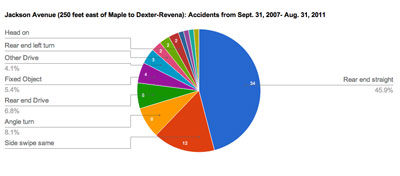
Accidents from 2007-2011 on the Jackson Avenue segment. The vast majority of accidents were straight rear end, followed by a substantial percentage of sideswipe accidents – likely a function of the narrow lanes. At 10 feet wide, the lanes are two feet narrower than the preferred 12 feet.
Data from 2004 through 2011 for Ann Arbor, taken from the Michigan Traffic Crash Facts website, are mapped below.
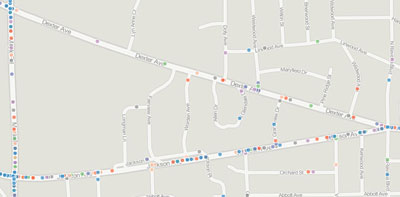
Accidents along Jackson Avenue. Dots are accidents, color-coded by year. Elsewhere in this article is a link to a dynamic map with the same data. The basic pattern of more accidents at intersections emerges fairly clearly.
Crash Data
A point of emphasis in the slide presentation by Dave Morena, highway safety specialist with the Federal Highway Administration Michigan Division, is consideration of older drivers. And a point of emphasis in the Michigan State University study is the importance of evaluating any decreases in accidents along a corridor in the context of a community’s overall accident rates. The MSU study also emphasizes the importance of evaluating crash types, not just overall numbers.
In that spirit, The Chronicle has assembled some charts and maps that demonstrate the accessibility of data from the Michigan Traffic Crash Facts website – which would allow for the detailed evaluation of a future 4-3 lane conversion along Jackson Avenue. The crash data website is a collaborative effort by the Michigan Office of Highway Safety Planning (OHSP) and the University of Michigan Transportation Research Institute (UMTRI). Data is available from 2004-2011.
Not all of the crash maps and data below are inherently related to the Jackson Avenue corridor. Some have been chosen based on likely community interest. For example, city councilmember Jane Lumm reports that she’s heard recently from residents who’d like to see the deer population culled – in part to reduce deer-car accidents. In the past, however, this idea has received some limited discussion, but not really gained very much traction with councilmembers or city staff.
Charts on accidents involving older drivers (> 59 years) are included, because discussion of Ann Arbor’s aging population has been noticeably more frequent at various city boards and commissions. No assumption of causality or fault is intended for crash data involving older drivers.

Ann Arbor crashes involving older drivers (> 59 years) as a percentage of total crashes. The upward trend, from 15% in 2004 to around 21% in 2011, can be interpreted as a clear indicator of Ann Arbor's aging population.
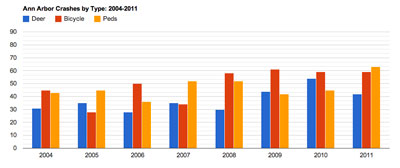
Ann Arbor crashes involving deer, bicycles and pedestrians from 2004-2011. All categories show a slightly increasing trend.
The Chronicle could not survive without regular voluntary subscriptions to support our coverage of public interest issues like lane conversions. Click this link for details: Subscribe to The Chronicle. And if you’re already supporting us, please encourage your friends, neighbors and colleagues to help support The Chronicle, too!







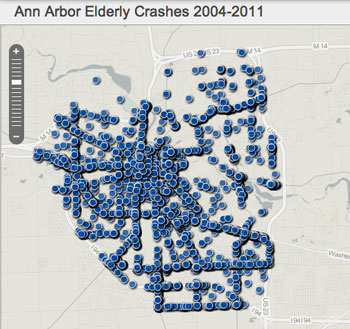
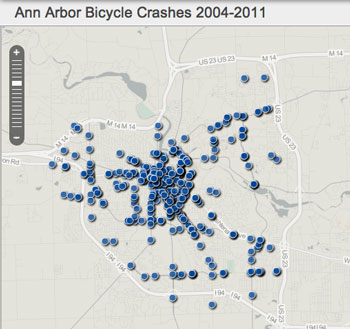
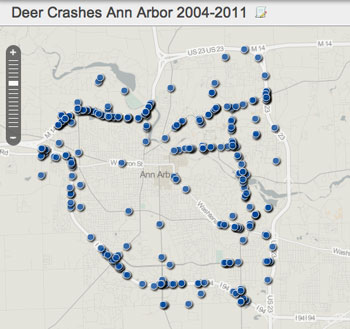
Can you comment on “how far back” there will be a wider footprint of lanes?
For example, will there still be a section of roadway just east of the Jackson/Maple intersection where there are two lanes for westbound traffic?
Heaven forbid that car drivers spend an extra 3 minutes on their commute for the sake of making it safer overall. Apologies for the sarcasm, but cheese and rice, people! If there’s one thing that Americans cling tighter to than guns and religion, it’s their cars—even in “Democratic” Ann Arbor.
@2: I do support the 4-to-3 conversion. I was just asking to have a full set of information. I believe the objectors are more concerned about the potential backup than the throughput (although the two are arguably different faces of the same issue).
Re: [1] Briefly, yes. The first image at the top of the article shows the transition from four to three lanes that takes place between Collingwood and Burwood, east of the Jackson/Maple intersection. So from the spot just east of Collingwood (where the four lanes begin to transition into the three-lane configuration) back to the Jackson/Maple intersection, there’ll be a section of roadway where two lanes are available just for westbound traffic, as there are currently. I measured that distance in Google Earth – from the stop line of the Jackson/Maple intersection – to be about 570 feet. Here’s a link to the uncropped image: [.pdf of Burwood transition]
Amazing graphics, Dave. FWIW, I support conversion.
I was at the first meeting supporting the change. A few additional points discussed their.
The county road commission chair came and strongly (!) supported the change as does the commission. ‘It will change how you view your neighborhood! For the better.’ They have done this in many other location and it has worked very well.
Several folks from across town who had this change said it greatly changed their neighborhoods and strongly supported the change (for them to come is very unusual).
The vast majority of those in attendance supported it.
This is a major GATEWAY to the city it looks and drives God Awful to say the least and is very unsafe roadway with no room for error to boot.
All (!) progressive communities are going to complete streets and so should we.
Our family are avid bike riders and reluctant car drivers and we feel this is to long over due.
When first discussed several years ago the Mayor was adamantly opposed. Glad to see he has finally come over to good reason even if it has taken so long.
Cars are no longer KING, even in Ann Arbor.
“is very unsafe roadway with no room for error to boot”
This is my feeling as I drive this road. Traffic is regularly faster than the posted limit, with people jostling for position within the pack and switching lanes. And the lanes are narrower than normal.
Thanks for the piece, though I’m curious about the outcomes of Ms. Hunter’s calls for a straw poll and/or Q/A.
As a linguistic issue, can I request that you consider using the word “crash” rather than “accident”? You’ll notice that MDOT preferentially uses the word “crash”, as do SEMCOG, WATS, and the American Association of State Highway and Transportation Officials (AASHTO).
The difference is that “accident” has an implication of “whoopsie-daisy! it’s too bad that happened, but it was totally random, unforeseeable, and unavoidable,” and ignores those crashes that actually could have been avoided, e.g. by waiting a few seconds for traffic to clear before turning, by leaving more following distance, by refraining from texting and driving, etc. on the driver side of the equation, but putting in a traffic signal, providing clear sight lines, etc. on the road engineering side.
When we’re talking about a project that’s specifically intended to address the design side of the crash equation (and, through design, support better behaviors on the driver side), I think the difference is significant.
@4: Thank you for the close-up PDF.
From a practical point of view, I understand why the city drops bike lanes as they get close to intersections, as there is often limited room, although it would be safer if they didn’t.
However, in this case, it doesn’t make much sense. It would seem there is plenty of room to widen the roadway west of Burwood just enough to include bike lanes all the way to the intersection, by chewing into West Park just a tiny bit.
Yikes.
I will fall into the older driver pool next year – >59. But, I can also fall into either column – biker or driver. Let’s hope I don’t fall into either – as an crash statistic.
@9: Do you mean Veterans Memorial Park?
This will be a welcome improvement. I hope some day we can get some proper crosswalks along this stretch too. Right now it’s a 16 minute walk from the crosswalk at Revena to the one at Maple.
I’d also like to note that this is really a four-to-five lane conversion, and will result in significantly more capacity for bicyclists.
@11: Yes, I confused the two parks. Sorry!
The “Jackson-Huron Neighborhood Association” is a new one to me. I’d be curious (if someone knows) when that Association came into existence and the other purposes to which the Association dedicates itself, other than questions of traffic in that narrowly defined corridor (Huron and Jackson, from Main to Maple). Thanks.
Thanks also to Dave for his in-depth reporting on the history of the issue. It seems to me a major issue for people who live along that road (my parents still live on Fairview, between Jackson and Dexter), along with the post-5:00 congestion on westbound Jackson. Often (around 5:30) this congestion extends from Maple all the way back to Worden and beyond, even with two lanes all the way down. I wonder whether the MDOT has any thoughts (in terms of timing the lights at Jackson and Maple, or whatever) about how to ease that congestion during the evening rush hour.
Another amazing piece of data analysis by the Chronicle!
I sure hope you stay local and don’t go national (where this quality belongs).
re (15) the scaleup costs would be horrendous.
Here’s one piece of info on the JHNA: [link]. Note it’s from 1999 though. I think they registered with the city and campaigned for a while to get people to slow down on Huron (as smirkily remembered here), and, like many groups that depend on the passion of individuals, have been sort of dormant ever since.
I miss AAIO.
Me too, with some reservations. I disliked her sneery tone and the tone of some of the discussion there–but it really changed my view of this town forever.